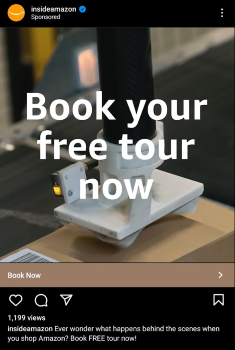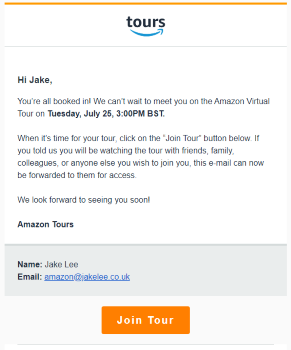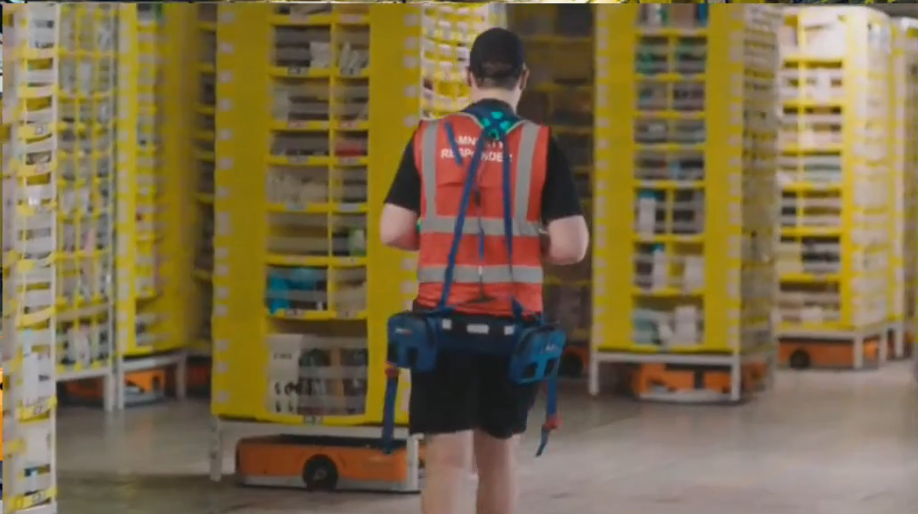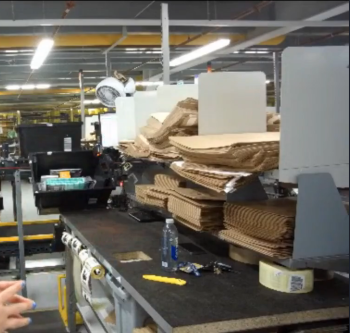
My experience attending Amazon's virtual fulfilment centre tour
Whilst scrolling Instagram recently, I saw a sponsored post to tour an Amazon factory. As someone who uses Amazon heavily, I was intrigued. This unfortunately turned out to just be a virtual tour, but I still decided to give it a go! And no, this isn’t a sponsored post, I promise 😅
The booking a spot and expectations parts of this article have been written before the actual tour.
Booking a spot
First, here’s the Instagram post that piqued my interest:
After booking a time that worked for me, I received a confirmation email. Interestingly, they seemed happy for the viewing link to be shared as widely as possible:
Looking at the Amazon tours FAQs, it looks like anyone can sign up for a tour, so if you like what you see in this post, maybe take one yourself!
Expectations
This section has been written after booking my tour, but before the actual event. I’ve intentionally avoided reading anything about the tour, so these expectations are likely to be very inaccurate!
So, let’s be realistic: if Amazon is sponsoring the ability to view a virtual tour, I don’t see why it would be anything less than a heavily scripted PR opportunity.
The virtual tour
It’s a half hour event, and based off my general experience with onboarding and user experience testing, I’m expecting something similar to:
- 5 minutes setting up, letting people check audio settings, misc delays.
- 10 minutes presentation / prerecorded video about Amazon the company, their goals, motivations, employees, etc.
- 10 minutes live tour through one of the fulfilment centres, paying special attention to their automation, employee experience, and how it all relates to the customer. Potentially a semi-scripted conversation with a surprisingly upbeat and enthusiastic employee!
- 5 minutes wrap-up, request for feedback, perhaps a small Q&A session.
Given the flak that Amazon often receives for how employees are treated, and fake merchandise sometimes being listed as genuine, I suspect these will be the focus areas. As Amazon is a very automation-heavy company, I expect their warehouse layout processes to be promoted heavily, and regular use of the “AI” buzzword.
Almost 8 years ago, I read this BBC article about Amazon’s algorithm reliance, and their techniques have undoubtedly evolved since then. Additionally, the tour will be of their (presumably more advanced) US centre.
The fulfilment centre
I’m actually not sure what the inside of a fulfilment centre will look like. I do have a few preconceived notions of an extremely carefully organised and well lit large warehouse, with robots performing almost all the actual work. As this is the “public” image of these warehouses, I expect the cleanliness, lighting, and spaciousness to be somewhat better than the average centre.
Interactivity
I strongly doubt there will be any part of the tour that is actually interactive.
Given that this is a controlled PR opportunity, I don’t see why those attending will have any ability to communicate with each other / the organisers, besides perhaps a (curated) Q&A session. I also doubt I’ll be able to see any information about how many people are attending, which is very understandable, but it would be nice to know if I’m part of a group of 10 or 1000!
The tour
Time has passed, and I have now been on the virtual tour!
I’ll run through what each part of the tour covered, along with the occasional screenshot. As this was primarily a live broadcast I didn’t feel comfortable capturing the presenters, so all images are from pre-prepared videos or the background of shots.
The ~45m tour included:
- 15:00 - 15:04: Intro
- 15:04 - 15:09: Robotics
- 15:09 - 15:13: Pick
- 15:13 - 15:17: Pack
- 15:17 - 15:20: SLAM
- 15:20 - 15:27: Q&A 1
- 15:27 - 15:34: Ship
- 15:34 - 15:43: Q&A 2
- 15:43: End & exit survey
Intro
Before the tour started, the invite link took me to a fairly standard “Reception” / lobby area, with a nudge to join “Stage” a minute or two before the stage started. As expected there was no interaction with other guests, or any indicator of how many people were there.
The tour started off with a very sleek and corporate prerecorded ~1 minute promotional video for the tours, which was essentially just an advert. Next, our tour guide “Hannah” introduced herself on camera, unexpectedly standing inside the UK fulfilment centre “MAN1” instead of a sleek flagship warehouse in the USA!
She gave a brief explanation behind the naming system (MAN1 = building 1 near airport “MAN” (Manchester)), and how this code is actually visible on all packages received by Amazon. Whilst a small and probably obvious detail, this fun fact was a great way to make it feel at least somewhat educational.
Throughout this, the relatively well known Amazon robots were driving around in the background, picking up stacks of items to move them around. I’d seen these before, but it was pretty interesting seeing them just going about their job without being the main focus. This led onto the next section: Robotics.
Robotics
This section was the one I was most looking forward to, but was sadly only 5 minutes long! Hannah in Manchester was joined by a colleague in FRA7 (Frankfurt building 7), who explained how the robots work at a high level.
I won’t go into detail about these robots, since it is all easily readable elsewhere. They are essentially little Roombas that drive under a stack of shelves, lift them up, and take them to a human at a picking station. They coordinate their routes with all other little robots in the warehouse, and work using QR codes on every stack of shelves and floor tile:
Interestingly, our tour guide discussed what happens when items occasionally fall off shelves: a human goes in to help! These are given the somewhat dystopian name “Amnesty Responders”, and put on a robot-nullifying identifier before entering the robot’s cage. Once inside, all robots anywhere near the responder stay perfectly still, so that the responder can fix whatever is wrong. This was all explained in a non-technical manner by another sleek marketing video.
This topic also segued neatly onto employees, a recurring theme throughout. The pretty standard sales pitch was given, about Amazon helping employees to progress, paying for some of their education, and how “employees are supported and looked after”. I’ll reserve my scepticism here for Impressions!
Pick
The robots take the yellow stack of shelves over to a “pick station”: a human putting items into boxes. For me this was a somewhat disturbing part of the tour, as the employee was referred to as a generic “picker”, despite clearly being within audible range. The picker also didn’t stop picking up and depositing items for the ~4 minutes the camera was focused on her.
As expected, Amazon’s algorithm-driven logistics beast defines in minute detail what the picker needs to do. It will visually highlight the shelf they need to pick an item from, then which box it should then be deposited in. And repeat. Again and again.
Our tour guide was careful to emphasise how the entire station was built to be as ergonomic as possible, and are “always improving with feedback from pickers”, however I’m pretty sure this setup is identical worldwide and doesn’t change. Images are available online, picking stations are essentially just robot-driven shelves on the left, depositing boxes in front!
Once the depositing boxes (“totes”) are full, they are pushed forward onto a conveyer belt for the next section: Pack.
Pack
Next up, a few minutes at the packing station with “Riyadh” where these boxes of items get turned into envelopes of items!
The packing stations are pretty simple, with totes of items coming in on the left, various envelope sizes in front, and of course a screen guiding the packer with exactly which envelope is needed. I didn’t want to include any of the employees here, so unfortunately only have a low quality cropped image of the packing station:
This was an opportune moment for our tour guide to discuss sustainability. Personally I recycle all my Amazon packaging (or use it for home composting), and it is genuinely impressive how little plastic they use (none?). Amazon is apparently aiming for net-zero carbon emissions by 2040, and packaging material is clearly a large part of this.
There’s not too much surprising here, besides the clearly well-practiced efficiency of the packer! One interesting part is around customer data: no employees up to this stage have seen any customer information. This is obvious in retrospect, but at this point there is now a packaged item, yet no destination information whatsoever. Instead, each envelope has an “SP” barcode on it that uniquely identifies each package. As Amazon’s system has already chosen which envelope size to use, and supplies these envelopes, it knows exactly which envelope contains which item. Clever!
Next up, getting this packaging information ready: SLAM.
SLAM
The oddly named “SLAM” stands for Scan Label, Apply Manifest, AKA printing address labels.
In the images below, packages enter from the right, get scanned, have a label printed and applied, then exit on the left:
| Leaving SLAM | Applying manifest | Scanning label |
|---|---|---|
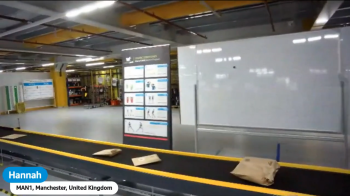 |
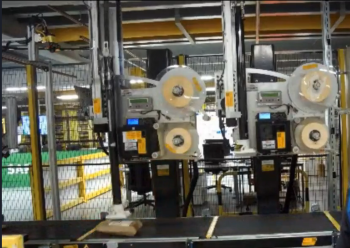 |
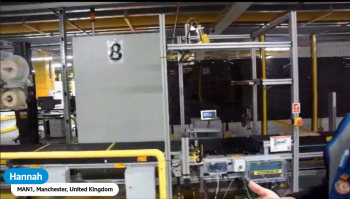 |
This step also includes checking the package’s weight is correct, and performs some other final checks before the package enters the shipping network. Any issues here are sent to a dedicated problem-solving team, presumably to figure out the rare instances where packages get mixed up.
In the “Applying manifest” step above, one of the two arms is mid-stamp. Interestingly, it apparently applies the label without any physical contact! Instead, the label is attached to the end of the arm, which is lowered to just above the package itself before a small burst of air actually releases and applies the label.
Now the package has a label, it’s ready to ship.
Ship
This section was perhaps the most futuristic, with lots of large conveyor belts moving packages around into larger crates, very very cool. A prerecorded video through the conveyor belt network was shown from a package’s point of view, which was as watchable as it was predictable!
The large crates at the end of conveyor belts are then loaded into pre-scheduled delivery trucks (in an algorithm-controlled efficient layout of course!). These trucks then make their way into various local logistics networks (e.g. a sortation centre then a delivery centre), and at this point the package is no longer the fulfilment centre’s responsibility. A short video was shown about deliveries being made to the Himalayas(!), which was clearly primarily marketing content. The ending sentence “Superheroes: Some wear capes, others deliver them” was a little much for me!
Q&As
There were 2 question and answer sessions, one to allow one of the tour guides to change locations, the other as a round-up at the end. As all questions were curated behind-the-scenes it’s hard to tell how many were asked, but those that were asked were relatively sensible. For example, some fulfilment centres output over 1 million packages per 24 hours, a pretty staggering number by any metric.
Another fun fact was that fulfilment centres often specialise. For example, “FRA3” is apparently entirely dedicated to clothing, whilst other centres specialise in technology, or furniture. Fulfilment centres are also extremely consistent between countries, with almost identical layouts, technology, and processes.
This section also revealed that there were guests from India, Canada, various US states, as well as myself from the UK of course. As only 2-3 states were named, I suspect the number of guests was around 20, but very hard to tell with any confidence.
Finally, the ~45m tour ended with a standard exit survey for feedback.
Tour feedback
I really enjoyed the tour! I gave feedback during the exit survey, essentially the only improvements I’d make is a greater focus on their software / hardware. Obviously I’m biased, but the allusions to “the algorithms” and “the system” were too vague for me, I’d have loved to know how all the different parts cooperate and how well their system understands the physical warehouse.
It would also have been good to see how the larger items (e.g. furniture) get packaged, since these items can’t neatly fit into the box-and-envelope based system we saw on the tour.
Since I discovered the tour via an Instagram advert, I can only assume most of the tours are Europe-based currently, and it was targeted advertising. As obvious as it sounds, having the majority of the information delivered from a relatable location in my country (Manchester, UK) made it a bit more “real”.
Impressions
So, what did I think?
It was interesting! The tour was as scripted as I’d expected, but following packages from shelf to truck really helped give a clear idea of how it works. Additionally, their focus on technology & pride in reliance on algorithms was appreciated, even though descriptions were only at a high level.
The tour guides seemed well-practiced, and handled the occasional minor quirk (e.g. video freezing) smoothly. It’s quite impressive having half hour of video inside a real warehouse and no obvious accidents / incidents anywhere, a solid testament to Amazon’s reliability. The overall impression was of a formidable logistics network that can handle pretty much anything us humans throw at it.
The sheer volume of packages constantly progressing throughout the tour made it easy see how Amazon handles millions of purchases, and often manages same or next day delivery when I buy random items. Economies of scale!
Whilst the experience was overall very positive, I did feel sympathy for the human workers inside the factory. Given the extremely high level of automation within Amazon, humans seemed to be used only when automating a task was impossible. Despite this, their work was unbearably monotonous and repetitive, with their entire job seemingly only existing until Amazon develops robots can reliably pick up and pack arbitrary items. This is only a matter of time.
Personally, my opinion on Amazon hasn’t changed much. I know they’re pretty rough for employees, are putting hundreds of local stores out of business, and undoubtedly make hard decisions to try and maintain their near-monopoly. That being said, of course I order from them all the time! They’re cheaper than competitors, reliable, refunds can be made easily, and overall provide an unbeatable customer experience. The main takeaway from the tour has been a greater interest in their automation technology, such as their next generation of robots.
Conclusion
In conclusion, I’m glad I clicked the tour advert and spent the time to watch. I wouldn’t have watched a 45-minute video about Amazon’s warehouses, but the live aspect makes it more interesting!
Whilst the tour was clearly very heavily scripted, the people talking did seem “real” and not just parroting company talking points. They obviously weren’t giving fully open opinions about their employer, however I suspect they were selected to be tour guides due to their genuinely positive opinions of Amazon.
One last time, if you’d like to take a virtual Amazon tour they happen pretty regularly, and are worth attending regardless of opinions on the company.
